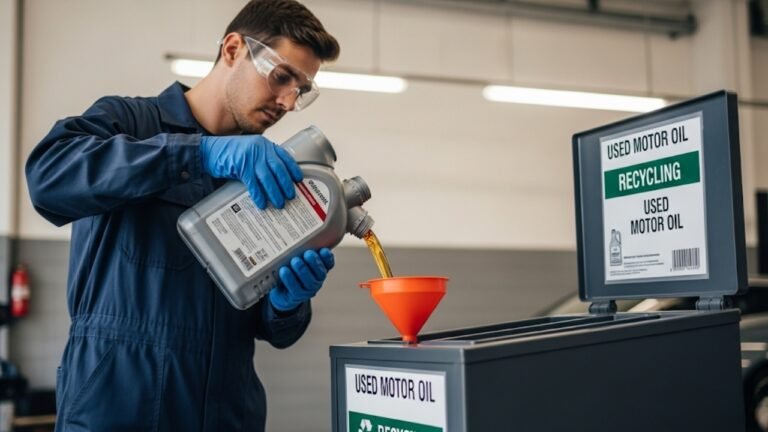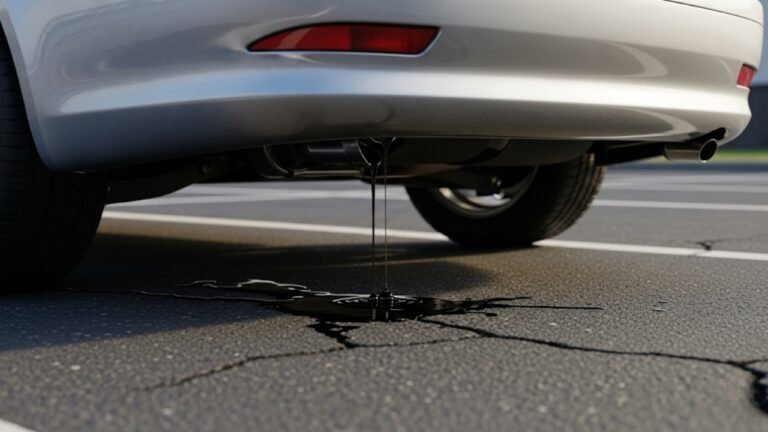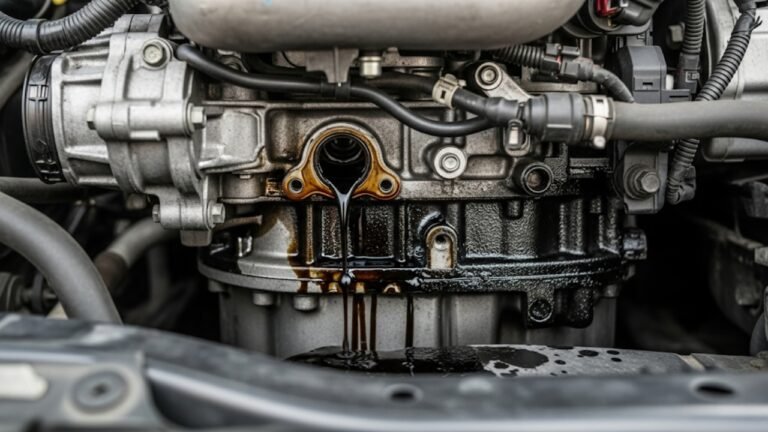Can You Drive Your Car With No Oil? The Honest Truth

Let me ask you something: have you ever wondered what happens if your car runs out of oil? It’s a scary thought, right? We often take engine oil for granted. We assume it’s just there, quietly doing its job. But what if it’s not? What if you forgot to top it off or fix a leak, and now you’re asking, “Can you drive your car with no oil?”
I get it. Life gets busy. Maybe you’re late for work or running errands, and checking oil is the last thing on your mind. But let me tell you from experience—driving without oil is like asking your heart to pump blood with no blood in your body. It might beat for a moment… but it won’t last long.
In this article, we’re diving deep into why oil matters, what happens when it’s missing, and whether there’s any safe distance you can drive without it. Spoiler: The answer may save your engine—or your wallet.
What Does Engine Oil Really Do?

Engine oil:
-
Lubricates moving parts
-
Reduces heat
-
Prevents rust
-
Cleans internal parts
-
Cushions engine components
Imagine running a marathon in jeans. That’s your engine without oil—chafing, overheating, and eventually shutting down.
Here’s a quick comparison of what happens with and without engine oil:
| Function | With Oil | Without Oil |
|---|---|---|
| Lubrication | Smooth metal contact, no wear | Metal grinds, fast wear |
| Cooling | Absorbs heat, cools parts | Overheats quickly |
| Cleaning | Traps debris in oil filter | Dirt and metal particles scratch parts |
| Sealing | Fills gaps between piston & cylinder | Loss of compression |
| Lifespan of engine | 200,000+ km possible | Engine failure in minutes |
So, to answer the big question—can you drive your car with no oil? Technically, yes. But only for a few seconds. And the damage is almost immediate.
Personal Story: The Day I Forgot to Check My Oil
I’ll never forget that morning. I had an early meeting and was rushing to get out the door. I knew my car had been leaking a little oil, but I figured, “I’ll top it up later.” Big mistake.
Ten minutes into the drive, my engine started knocking. A low rumble turned into a loud clank. I pulled over. The engine seized. There was no oil left.
A few weeks and a $2,500 repair bill later, I learned the hard way. That’s why I always remind people now: checking oil isn’t optional—it’s essential.
Can You Drive Your Car With No Oil At All?
Let’s get into the heart of it. Can you drive your car with no oil?
Here’s the brutal truth:
Driving with zero oil will destroy your engine. No maybes. No mights. No second chances.
Here’s what happens, step by step:
-
Friction builds instantly – No oil means metal rubs metal.
-
Heat increases rapidly – Parts get so hot, they warp or melt.
-
Knocking sounds begin – Pistons hit the cylinder walls directly.
-
Seizure occurs – Engine locks up completely.
-
Total failure – You’ll need a full rebuild or new engine.
Sometimes this all happens in under 5 minutes.
So even if your car technically moves, it’s like sprinting on broken legs—you’re only making it worse.
Why People Drive Without Oil (And Why You Shouldn’t)
You’d be surprised how often people end up driving without oil—not because they want to, but because they didn’t realize something was wrong.
Common reasons:
-
Forgetting regular oil changes
-
Ignoring dashboard oil light
-
Not checking for leaks
-
Believing myths like “synthetic oil lasts forever”
But trust me—none of these excuses save your engine.
Here’s an emotional angle: Think about your car as a teammate. Would you let your teammate run a marathon with no water? Of course not. That’s what no oil feels like for your engine.
Signs You Might Have No Oil (Before It’s Too Late)
Knowing the early warning signs can save your engine and your money. Here are clear red flags that your car might be running dangerously low on oil:
-
Oil warning light on dashboard
-
Burning smell from engine
-
Clunking or knocking sounds
-
Poor performance
-
Overheating without warning
-
Smoke from exhaust or hood
If you notice any of these, stop driving immediately and check your oil level. It’s better to be late than stranded—or broke.
How Long Can You Actually Drive With No Oil?
Let’s break this myth: “Maybe I can drive a few kilometers without oil.”
In reality, the answer is:
30 seconds to 2 minutes—maximum.
After that, the engine starts dying. Some drivers have made it a few kilometers, but always at the cost of total engine destruction.
Think of it like this:
-
Driving 2 minutes = $3,000 repair
-
Topping up oil = $30 solution
It’s a no-brainer.
What To Do If You Accidentally Drove With No Oil
Mistakes happen. If you just realized you drove with little or no oil, don’t panic. But act fast.
Here’s what you should do:
-
Pull over immediately
-
Turn off the engine
-
Let it cool for 30 minutes
-
Check oil dipstick
-
Add oil if possible
-
Call a mechanic or tow truck
Even if your engine seems fine, internal damage might already be happening. Getting a quick diagnostic check could prevent worse damage.
How to Prevent Driving Without Oil (Simple Habits, Big Savings)
Prevention isn’t just smart—it’s way easier than dealing with engine failure. Trust me, I’ve been there.
Here’s what you can do to make sure you never drive your car with no oil again:
✅ Check Oil Every 2 Weeks
-
Pop the hood and pull out the dipstick.
-
Wipe it, reinsert, and pull again to check level.
-
Make sure the oil is between the min and max lines.
-
If it’s low, top it up.
✅ Watch the Dashboard Lights
-
Don’t ignore the oil pressure light.
-
Even if it flickers, pull over and check.
✅ Schedule Regular Oil Changes
-
Every 5,000–10,000 km, depending on your oil type.
-
Synthetic lasts longer but still needs checking.
✅ Look for Leaks Under the Car
-
Dark brown or black puddles? That’s probably oil.
-
Get it checked before it empties your engine.
✅ Listen to Your Engine
-
Knocking, grinding, overheating—all signs you might be in trouble.
-
If it sounds off, it probably is.
A few seconds of attention each week can save you thousands in repair costs. And if you’re someone who drives a lot, checking your oil becomes as important as filling your gas tank.
Cultural Nuance: Why This Matters More in Hotter Climates
In places like Bangladesh, India, or the Middle East, the risk is even higher. Why? Because hot weather speeds up oil breakdown.
High heat causes:
-
Faster evaporation of oil
-
Thinner oil viscosity (less effective lubrication)
-
Higher engine stress, especially in traffic jams
In these regions, it’s not uncommon to see older cars stalling or smoking—often because the engine was running dry in the brutal heat.
So if you’re living in or traveling through hot climates, it’s crucial to check your oil more often than the manual says.
Emotional Insight: Your Car Is Like Family
Here’s the thing—a car isn’t just a machine. For many of us, it’s our ride to work, to school, to weddings and funerals. It carries your kids, your groceries, your dreams. It deserves care.
Just like you wouldn’t neglect someone you love, don’t ignore your car’s basic needs. Driving with no oil is like abandoning your car in a crisis.
If you think of your car this way, you’ll never forget to check the oil again.
Step-by-Step: How to Check and Refill Your Engine Oil
If you’re new to this, no worries. Here’s how to check and refill your oil in under 5 minutes.
What You’ll Need:
-
Clean rag
-
Your car manual
-
Engine oil (same grade as recommended)
-
Funnel (optional)
️ Steps:
-
Park on level ground, turn off engine, and wait 10 minutes.
-
Open hood and locate the dipstick (usually a bright yellow ring).
-
Pull it out, wipe clean, reinsert, and pull again.
-
Check oil level:
-
Between marks = Good
-
Below lower mark = Add oil
-
-
Unscrew the oil filler cap, pour oil slowly.
-
Wait 1 minute, recheck level, don’t overfill.
-
Close everything tight and you’re done.
✅ Pro Tip: Always carry a small bottle of oil in your trunk. Like an umbrella, you may not need it often, but when you do—it’s a lifesaver.
FAQs: Can You Drive Your Car With No Oil?
1. How far can I go if my car runs out of oil?
Only a few minutes, maybe 1–2 kilometers before the engine suffers serious damage or seizes. It’s not safe to drive.
2. Will the car even start without oil?
Yes, it might start. But it won’t run well for long. It will overheat quickly and break down.
3. Is low oil the same as no oil?
No. Low oil means there’s still some lubrication left. But no oil means total lack of protection, and the engine will fail fast.
4. Can synthetic oil prevent engine damage without topping up?
No oil, whether synthetic or conventional, can protect your engine if there’s none of it left. Synthetic may last longer but doesn’t make you invincible.
5. Why does my oil keep disappearing?
Possible reasons include:
-
Oil leaks
-
Burning oil due to worn piston rings
-
Faulty seals or gaskets
Always check for visible leaks or blue smoke from exhaust.
6. What does the oil light really mean?
It means oil pressure is dangerously low. Not always that you’re out of oil—but it’s a red alert. Stop the engine.
7. Can I refill oil without changing it?
Yes, but only short-term. Regular oil changes are still necessary to remove sludge, carbon, and old deposits.
8. How expensive is engine damage from no oil?
It can range from $2,000 to $7,000 depending on damage. In some cases, it’s cheaper to buy a new engine—or a new car.
The Real Cost of Ignoring Oil
Let’s do some math:
-
Regular oil change: $30–$60
-
Engine repair/replacement: $2,000–$6,000+
-
Towing fee: $50–$150
Skipping that simple check could turn into a multi-thousand-dollar nightmare. And worse, you might be stranded in the middle of nowhere.
Conclusion: Respect Your Engine—It’s the Heart of Your Car
So, can you drive your car with no oil?
Technically, yes—for a minute. But should you? Absolutely not.
It’s like running barefoot on broken glass. You might move, but you’ll hurt yourself in the process.
This isn’t just about car care. It’s about self-respect, responsibility, and wisdom. You depend on your car for so much. Show it some love back. Check the oil. Top it up. Don’t delay oil changes.
Because in the end, it’s cheaper to be careful than to be careless.






